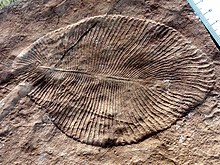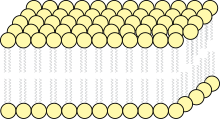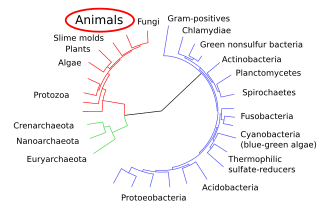Structuralism (biology)
Biological or process structuralism is a school of biological thought that objects to an exclusively
Structuralists have proposed different mechanisms that might have guided the formation of
Darwinian biologists have criticised structuralism, emphasising that there is plentiful evidence both that natural selection is effective and, from
History
Geoffroy's law of compensation
In 1830, Étienne Geoffroy Saint-Hilaire argued a structuralist case against the functionalist (teleological) position of Georges Cuvier. Geoffroy believed that homologies of structure between animals indicated that they shared an ideal pattern; these did not imply evolution but a unity of plan, a law of nature.[b] He further believed that if one part was more developed within a structure, the other parts would necessarily be reduced in compensation, as nature always used the same materials: if more of them were used for one feature, less was available for the others.[4]
D'Arcy Thompson's morphology
In his "eccentric, beautiful"[5] 1917 book On Growth and Form, D'Arcy Wentworth Thompson revisited the old idea of "universal laws of form" to explain the observed forms of living organisms.[1] The science writer Philip Ball states that Thompson "presents mathematical principles as a shaping agency that may supersede natural selection, showing how the structures of the living world often echo those in inorganic nature", and notes his "frustration at the 'Just So' explanations of morphology offered by Darwinians." Instead, Ball writes, Thompson elaborates on how not heredity but physical forces govern biological form.[6] The philosopher of biology Michael Ruse similarly wrote that Thompson "had little time for natural selection", certainly preferring "mechanical explanations" and possibly straying into vitalism.[1]
Seilacher's pneu structures

Like Thompson, the palaeontologist Adolf Seilacher emphasised fabricational constraints on form. He interpreted fossils such as Dickinsonia in the Ediacaran biota as "pneu" structures determined by mechanical inflation like a quilted air mattress, rather than having been driven by natural selection.[7][8]
Wagner's constraints on development
In his 2014 book Homology, Genes, and Evolutionary Innovation, the evolutionary biologist Günter P. Wagner argues for "the study of novelty as distinct from adaptation." He defines novelty as occurring when some part of the body develops an individual and quasi-independent existence, in other words as a distinct and recognisable structure, which he implies might occur before natural selection begins to adapt the structure for some function.[2][9] He forms a structuralist picture of evolutionary developmental biology, using empirical evidence, arguing that homology and biological novelty are key aspects requiring explanation, and that developmental bias (i.e. structural constraints on embryonic development) is a key explanation for these.[10][11]
Kauffman's self-organisation

The mathematical biologist Stuart Kauffman suggested in 1993 that self-organization may play a role alongside natural selection in three areas of evolutionary biology, namely population dynamics, molecular evolution, and morphogenesis. With respect to molecular biology, Kauffman has been criticised for ignoring the role of energy in driving biochemical reactions in cells, which can fairly be called self-catalysing but which do not simply self-organise.[12]
Denton's 'Types'
The biochemist
Gould and Lewontin's spandrels
In 1979, influenced by Seilacher among others, the
Müller and Newman's pre-Mendelian evolution
Extreme structuralists like
Goodwin's morphogenetic fields
What Wagner calls "a fringe movement in evolutionary biology",[2] the form of structuralism exemplified by Brian Goodwin,[2][21] effectively denies that natural selection is important,[2][22] or at least that biological complexity could be reduced to natural selection.[22][23] This led to conflict with Darwinists such as Richard Dawkins.[24] Goodwin related the old concept of a morphogenetic field to the spatial distribution of chemical signals in a developing embryo.[25] He demonstrated with a mathematical model that a variety of patterns could be formed by choosing parameter values to set up either static geometric patterns or dynamic oscillations,[22][23] implying that the signalling system involved was somehow an alternative to natural selection.[15] Dawkins commented "He thinks he's anti-Darwinian, although he can't be, because he has no alternative explanation."[26]
Criticism

While agreeing that pattern formation mechanisms such as those described by Goodwin exist, the biologists Richard Dawkins, Stephen J. Gould, Lynn Margulis, and Steve Jones have criticised Goodwin for suggesting that chemical signalling forms an alternative to natural selection.[15]
Moran, a "skeptical biochemist", comments that 'structuralism' is a "new buzzword ... guaranteed to impress the creationist crowd because nobody understands what it means but it sounds very 'sciency' and philosophical."[15] The philosopher of science Paul E. Griffiths writes that structuralists "view this structuring of the space of biological possibility as part of the fundamental physical structure of nature. But the phenomena of phylogenetic inertia and developmental constraint do not support this interpretation. These phenomena show that the evolutionary pathways available to an organism are a function of the developmental structure of the organism."[27]
Moran summarizes: "There's nothing in science that supports the views of the structuralists. We have perfectly good explanations for why bumblebees are different than mushrooms and why all vertebrates have vertebrae and not exoskeletons. There's no evidence to support the idea that if you replay the tape of life it will come out looking anything like what we see today. You can be confident that when you visit another planet you will not find vertebrates."[15]
The
See also
- Alternatives to Darwinism
- Eclipse of Darwinism
- Extended evolutionary synthesis
- Orthogenesis
Notes
- ^ Gregor Mendel pioneered the study of genetics.
- ^ In this, Geoffroy's homologies were like Aristotle's forms.
- Platonic realism.[13]
- ^ The artist Theodore Cook's The Curves of Life, Constable, 1914 to some extent anticipated D'Arcy Thompson, exploring spirals in art and nature.
- ^ Held's final point was that the cracks in the crocodile's skin are genuinely explained by cracking, unlike all the other examples he lists.[28]
References
- ^ ISBN 9780739174371.
- ^ ISBN 978-0691156460. Pages 7–38, 125
- ISBN 978-0-8018-4391-4.
- ^ Racine, Valerie (7 October 2013). "Essay: The Cuvier-Geoffroy Debate". The Embryo Project Encyclopedia, Arizona State University. Retrieved 10 December 2016.
- ISBN 978-1-4088-3622-4.
- S2CID 205076253.
- ISBN 978-3-642-76158-4.
- .
- ISBN 9780691156460. Retrieved 9 December 2016.
- S2CID 82602032.
- (PDF) from the original on 26 September 2017.
- PMC 1226010.
- ^ Silverman, Allan. "Plato's Middle Period Metaphysics and Epistemology". In Zalta, Edward N. (ed.). Stanford Encyclopedia of Philosophy.
- .
- ^ a b c d e f Moran, Laurence A. (2016-02-02). "What is "Structuralism"?". Sandwalk (blog of a recognised expert). Retrieved 9 December 2016.
- S2CID 2129408.
- ^ PMID 21276788.
- PMID 16299770.
- PMID 16479496.
- PMID 15363407.
- )
- ^ JSTOR 2410461.
- ^ JSTOR 29775684.
- ^ Brian Goodwin obituary - The Guardian, 9 August 2009
- doi:10.1086/420070.
- ^ Dawkins, Richard (1 May 1996). "Chapter 3 "A Survival Machine"". Edge. Retrieved 11 February 2018.
- S2CID 146674266.
- ^ ISBN 978-1-107-62139-8.
